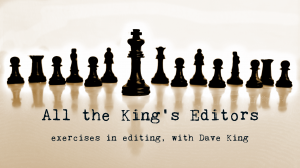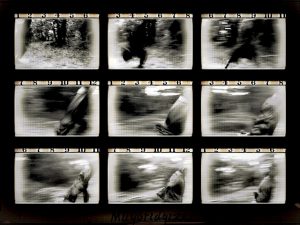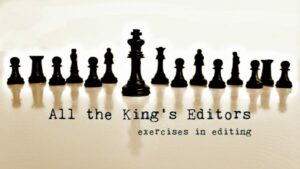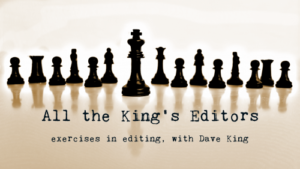Editing
If you want to learn how to write more effectively (and if you’re reading this, I assume you do), the hardest lesson you face is learning how everything else you learn fits together. Context controls everything. Techniques that work in one situation won’t work in another. Change one aspect of a scene and you wind up rearranging everything around it. The kind of juggling you have to do to keep up can be mind bending, and it’s hard to learn it from articles because you can’t talk about specific context in general terms.
That’s one reason we started the Editor’s Clinics – so you can see how editorial changes work in their natural habitat. This month, we’re going even further. For last month’s clinic, I edited a passage assuming that it was the opening scene of the novel. Turns out I got that wrong – the author contacted me to let me know that the passage comes from the middle of the book.
She’s also provided some additional context on the story. Dusty got a job on Pat’s ranch and brought Jaelle, his sister, with him, hoping she would be hired as well. Instead Pat, the wealthy owner, was so taken with her that he planned to marry her. Dusty, for his part, has been either solicitous of Jaelle (usually when people are watching) or controlling (when they’re alone).
Then Pat is shot while out hunting. One of the men who was with him has been arrested for the murder. But Bianca, a rookie with the RCMP and one of the first people on the scene, doesn’t believe he did it. (Jaelle was also there that day, but her horse bolted at the shot and she doesn’t know what happened to Pat.) Bianca is running her own investigation and getting to know Jaelle to learn some background. She’s also slowly and genuinely befriending Jaelle, who after the isolation on the ranch welcomes the kindness.
So, with that background, here’s the new edit of the passage. I know it’s a bother, but I’d encourage you to compare it to last month’s version. And you can see clean copies of both versions here.
Read MoreThe last time I edited some of my work, I was dismayed to discover how many times my characters smiled, sighed, or scowled and how infrequently they used any other gestures. What, I thought, if my characters didn’t just smile, sigh, and scowl? What if they clapped hands and skipped around the room beaming? Or thumped down with a huge outrush of air, to settle in for the long tedious wait? Or leaned threateningly in towards the bully, elbows out, legs stiffened, features frozen? What if my characters could gain a much more nuanced, much more expressive range of gestures and emotions?
As I contemplated fancying up my emotional descriptions, I remembered Keith Cronin’s sage advice about pretentious words and had a reality check. Was I just getting carried away with word-love again?
Then I adopted a former stray dog, and my eyes were opened. She entered the house fully formed, with her own expectations, habits, and history. All I had to go on to figure out what she wanted or needed were her facial expressions, subvocalizations, and posture. I learned the subtle nuances of one dog ear raised, a short whine, a long whine, a big sigh. Figuring out what she was trying to ‘tell’ me had a big payoff (no messes, less chewing of items, a happy dog). This close observation became a habit, and I started watching people in everyday conversations.
Just how much of what is ‘said’ does not occur through words is astonishing. Researchers have estimated that more than half of communication (estimates range from 65% to 90% by various investigators) is non-verbal. The same words will mean different things depending on tone of voice, accompanying facial expression, posture and position of the speaker, even clothing and appearance. First impressions happen within 1/10th of a second. Or less. And they are mostly based on non-verbal communication.
There has been a lot written on non-verbal communication–even Charles Darwin wrote a book about it. (Links to a few more recent studies can be found at the end of this blog.) A lot of current research appears in psychology studies, an equally large amount appears in guides to business success, since non-verbal communication is a crucial part of making presentations and deals. I found surprisingly little written on the glorious possibilities it offers for writers of fiction. A simple summary of the characteristics of non-verbal communication reads like a checklist of strategies for improving flat scenes:
Non-verbal communication:
For the last couple of clinics, we’ve been looking at opening scenes that successfully introduced intriguing characters in a dramatic situation. This morning, we’re looking at a less successful example. I’ve included my comments at the bottom, so read the edited piece over and see what you think.
Incidentally, if you would like to submit your work to the clinic (and I hope you do – submission guidelines are here), you might consider sending in a key dramatic scene from the middle of the work. Please include a quick paragraph explaining who’s who, what they’re doing, and why it matters. It’s natural to submit the opening of your WIP, and hook is important. But the importance of the hook can be overrated, and it’s worth looking at other aspects of writing.
Dusty would be mad,. Jaelle was sure of it. She hadn’t told him of her plans because she knew that, and she wasn’t even sure Bianca would show up. Besides, she instinctively knew he wouldn’t have let her go. [1]
Those first months in Houston, after she came to live with him he wanted to know where she was and who she was talking to every minute of her day. She had to give up the few friends from school that she’d kept in touch with. It had been okay then, even though she’d lost her few friends, because she was crazy about Dusty and excited at the prospect of being part of a family. He was just very She just figured real families were protective, she had told herself. That’s how real families are, she thought, since she had never been part of a real family before. Yes, she thought, Dusty will be mad when he finds out I’ve left the ranch with the cop. For now, she just looked out the car window and tried not to think about what would happen when she got home.
Read MoreI recall the frustration I felt when, after having worked on my first novel for over two years, I was still able to sit with my printed pages and create a mess of red-line edits for myself.
No, this word is better.
This sentence is drivel.
Move this graph over there. Nope, nope—there.
She would never say that, ug.
WHAT DOES THAT EVEN MEAN?
Was I beyond capricious? Hard-core stalling? Lacking in the ability to know when done was done enough?
Then, a miracle: a day when I read through my printed pages and left far fewer notes for myself. Some scenes had only a couple of red-pencil markings. Some none at all. That day turned into a string of days, and the pile of pages for which there were few if any notes grew.
Had I become less picky? More eager to move on? A far better writer?
Nope. Nope. And (mostly) nope.
Imagine two people out on a boat on a lake at sunset. Later, you’ll ask them: What did you see? And you’ll receive different reports, be informed about different details.
There was a barking dog. A face-planting skier. A huge spider somewhere in the boat.
Huh. I forgot my glasses and saw only muted colors in the sky…
These different perspectives make easy sense to us, as those two people climbed into that boat with different eyes, minds, dispositions, attention spans, angles, meals in their stomachs, aches and pains in their bones, visual acuity, and so on. But here’s what you may not realize: You, too, are like those two people on the boat. Yep, both of them. Or maybe there are thousands of them.
WHAT?
On any given day, you are seeing your work from a singular angle—a day (hour, minute) that will never be again, with a you that will never be quite the same again. This is your perspective on day 16,885 of a life, perhaps, or day 488 of your wip, or day 1,309 of a marriage, or day 3 of really crap sleep (which is barely distinguishable from hour 3 of a diet). These versions of yourself will continue to change, and hopefully to evolve, just as your story will change and evolve.
And it’s all good.
Because unless you’re a truly miraculous writer, your best ideas will not come when you’re staring at the blinking cursor of Draft One. In fact, they will not come on any single day. Rather, a symphonic effort via your many shades of self will be required to evolve word craft, three-dimensional characters, and out-of-the-box ideas.
You will change.
Your voice may shift.
Your tolerance for sub-par writing may become less tolerant.
You may have epiphanies over lunch, at dawn, or as you’re about to fall asleep. They may come while you’re in the shower or out walking the dog. On the other side of it, yesterday’s epiphanies may look sophomoric and wind up alongside a hundred other possibilities in your computer’s trash bin.
But, if you continue through all of your shades-of-self work—the crossing off and rewriting and doubt and angst—you’ll find it:
Read MoreEnsuring consistency is a big part of my work as an editor. As I work through a book I make sure there are no variations in how words are spelled: it should be either while or whilst, never both in the same text. The same with words like among/amongst, towards/toward, and O.K./OK/ok/okay. Numbers below 10 are either written out or not. Or all numbers are written out. Or not. Or only when accompanied by a measurement, e.g. all six competitors were over 6 feet tall.
Chapter titles should all be the same: centered or not, same typeface throughout. Any lists should have the same punctuation each time they appear: a period, semicolon or nothing at the end of each line. Always one or two spaces after a period, never sometimes one and sometimes two (but let’s not get too deep into that discussion).
Editors use a style guide to keep all this consistent, sometimes following an established one, like the Chicago Manual of Style, as well as keeping an individual style guide for each new book to make sure the particularities of that book, or series, are always the same, such as character names and place names. Does the character have blonde hair (or even blond hair)? How many children does the character have, if any, along with their age, size, occupation and so on.
These are all easy to keep track of and easy enough for an editor to change. It’s part of the job. What’s more difficult to revise is when characters don’t behave consistently. And that can happen very easily.
Avoid a major rewrite
Maybe your hero has always been a good friend but chooses to go watch a movie rather than bail his best buddy out of jail. If the buddy gets out of prison the next day and they argue about the bail before the story continues, then there’s not much of a problem. If the buddy dies in jail and that’s what sends the hero to investigate the death, it could look contrived, a touch too convenient that the hero was at a movie that night.
Such inconsistencies can lead to major revisions, a bigger rewrite than you were hoping for. And it’s better to catch these things before you send your manuscript to an editor—and definitely before submitting it for publication—because a major rewrite is likely to mean at least one more round of copy-editing.
And it’s easier than you might think to introduce character inconsistencies into your writing. You could have had a long break between writing chapters because, well, that’s how life goes. Or it could be that you don’t yet know the characters well enough to know how they’ll react to each specific situation.
There’s not a lot you can do when life gets in the way. You can try to develop good writing habits, write at particular times every day or week, set goals to write for an hour, two hours or 1,000 words at each sitting. But eventually something will happen to get in your way again.
Discover your characters
There are, however, various ways to help you get to know your characters and make sure they react consistently throughout your manuscript.
Read MoreThis is another installment in our periodic editing program here at Writer Unboxed. The piece I’ve chosen for this particular exercise shows some real talent in description, setting, pacing, and dialogue, and it was enjoyable to read.
That said, it lacked dramatic focus, and too much of what was happening felt muddled or underdeveloped, so that the extended scene that comprises the piece had considerably less emotional impact than it could have. Much of what I say here will be focused on how we might improve that.
One of the difficulties in editing the piece was trying to discern the author’s intent given the muddled emotions and desire-line in the scene. This created constant uncertainty as to how to go about improving the piece. (It’s also one of the reasons this post is so long–sorry.)
Another difficulty resulted from not knowing from the outset whether it was intended as a short story (because its title, “Knowing When to Quit,” suggested a self-contained whole) or a chapter in a longer work. Given the number of references to incidents and characters outside the text itself—for example, the death of Eddie’s best friend, Nick, and the existence of the “Agency,” etc.—I decided that it was part of a larger work, and that the title was intended as a chapter title .
I’ll first present the text as edited. I have used bracketed numbers referencing my changes, and employed underlining where I have added text. My comments as to why I’ve made the changes will appear with those numbers for reference after the edited text. Then I’ll discuss in greater detail the more developmental aspects of what I would propose if I were the editor on this project.
*****
Knowing When to Quit
The shiny spot on the bronze pig butt mounted above the entrance to The Brass Tail was tempting, but Josh preferred making his own luck. [1] The Marina district of San Francisco was eight miles and a world away from the sunlit streets of Sausalito. He’d left Kat there in the lengthening shadows, stubborn as ever in refusing his offer of help. Here, fog had reclaimed the streets, muffling traffic noises and sucking away the day’s warmth. [2]
Cold, damp, San Francisco fog air pooled around him Josh’s legs as he stood in the entry, taking . He stamped his feet and took a moment to absorb the energy of the room. [3] Despite her being eight miles away in sunlit Sausalito, Kat’s vibe saturated everything. She didn’t just own the place, she haunted it. [4]
Read MoreImage – iStockphoto: Kristina Jovanovic
Hemming in the Tension
When I tweeted up the author Anne R. Allen for writing that “Word count guidelines have been trending down in the last decade,” I found our colleague Hugh Howey checking in from a galaxy far, far away to say, “Slaughterhouse Five, Frankenstein, and Fahrenheit 451 are three of my favorite sci-fi works of all-time, and each is around 50K. The problem part of most novels is the boring middle bit. Best to just leave that part out.”
The desired price of the hardback began to determine the length of the manuscript, which is a weird way to do art. Personally, I'd read more fantasy novels if they came in smaller size but more often. Waiting 7 years for a 1,500 page tome is no bueno.
— Hugh Howey (@hughhowey) March 21, 2018
He’s right, of course, as is Anne Allen, and we went on to discuss (briefly!) the problem some big-name authors run into in this regard, too. I call it the Clancy effect. Once they’re established as a publishing house’s majors, the editorial touch gets lighter, often more pixie dust than anything else. Typos are caught, we have to hope, but developmental work (“structural” edits to your British neighbors) goes out the window.
That can go to anybody’s head, and many of us can name an icon whose work got leggier and sadly shapeless as the big career flabbed on.
I've seen this personally when I edit anthologies. The bigger the name, the more umbrage the author takes with any suggestion. I think writing can get worse over a career because of the unwillingness to be edited (and laziness from the publisher).
— Hugh Howey (@hughhowey) March 21, 2018
Too Much Entertainment
Provocations graphic by Liam Walsh
At London Book Fair last week, another element of this issue came into sharper focus as I moderated a panel for the Byte the Book organization, which looks at the industry from the digital vantage point.
While the session was titled “Publishers Go Prospecting: Finding Hidden Treasure in Your Content,” I’d worked out with our four fine panelists (from the BBC, Penguin Random House, Vodafone, and Hodder Education) an approach that would take us past the obvious issues of spelunking for good backlist titles. (Bring Up the Bodies, as Hilary Mantel might say.)
We looked at today’s mushrooming level of competition for reading time from really fine television and film. After all, you may have felt the first really deep tremor of storytelling’s new cinematic leadership in February when Amazon Publishing created its Topple Books imprint in direct collaboration with Amazon Studios and the activist-filmmaker Jill Soloway (Transparent, I Love Dick, Six Feet Under).
Tom Goodwin
As the futurist and corporate strategist Tom Goodwin told me, “Book publishing is not in the ‘text industry.’ It’s not in the ‘reading industry.’ It’s in the ‘what do people want to spend their time doing? industry.’”
And that’s where the rubber is going to increasingly meet the shortest road possible.
Read MoreThis morning we’re looking at another effective opening. Like last month’s example, the first scene isn’t simply dramatic but introduces a likable character (named November) finding a moment of peace in an otherwise miserable life.
But even more, it introduces readers quite effectively to an alternate metaphysics. Note how the author ramps up the strangeness slowly. November’s initial comment about hanging out with the dead in the cemetery could simply refer to the bodies. Then she spots Victor and we learn that she is actually seeing dead people. Then we get another twist, two paragraphs later, when we learn she’s been committed over this vision in the past and so may not actually be seeing what she thinks she’s seeing. Also, I think it’s implied that Victor was talking to the dead (I’ve made that more explicit), which raises the additional question of just who and what Victor is.
Then, with these questions bubbling around, November sees her mother’s ghost – unless she doesn’t, really. Readers don’t know if November’s mother actually died and how, whether November is delusional or genuinely seeing dead people, and just who (or what) Victor is. That’s a lot of reasons to keep reading packed into a small space.
There are a couple of things that still detract. One is, the author frontloads the piece with a bit too much unnecessary information about November’s family – an easy temptation to fall into. Another – and this is true across genres – is that a more intimate point of view will help draw readers into the main character’s world. I’ve edited things so as to make November’s internal state more consistent and inviting.
So here’s how the piece looks after a little polishing.
Read MoreThis post is the next in the ‘All the King’s Editors’ series, the brainchild of WU contributor Dave King. In this series, WU contributors edit manuscript pages submitted by members of the larger WU community, and discuss the proposed changes.
This is intended to be an educational format, and we hope this exercise will generate useful comments about the proposed changes–why the editorial suggestions do or don’t work. Each participating editor will approach a submission in a unique way, and speaks only for him or herself.
If you’re interested in submitting a sample for consideration, click HERE for instructions.
* * *
Hi friends. First of all, I’d like to applaud the brave submitters. It takes courage to submit work for feedback, especially in this public forum.
You’ll see what I have added or moved (in red); the strikethrough shows what I have deleted. While it looks like I deleted and added significant sections, it’s really that I moved sentences around. This writing is really tight as is.
The Submission:
Maggie sets her wine glass down and sweeps a handful of rose petals off the table and into her palm. The rose bush, which blankets the pergola, has been dropping petals all evening. They litter the white embroidered tablecloth, and form drifts around the half-dozen empty wine bottles. When they fall into the flickering votive candles, they sizzle and send plumes of black, acrid smoke into the dark night.
Maggie holds her palmfull of petals toward her sister and raises her eyebrows. “How about a crown?”
When Justine doesn’t protest, Maggie yanking her sister’s chin face toward her begins arranging She arranges the pale pink petals in a circle on her sister’s Justine’s crown of dark hair.
“Just like when we were kids,” Justine says. “You were always the crown-maker.” The rose bush, which blankets the pergola, has been dropping petals on them all evening. They litter the white embroidered tablecloth, and form drifts around the half-dozen empty wine bottles. When they fall into the flickering votive candles they sizzle and send a plume of black, acrid smoke into the dark night.
Maggie smiles, focusing on the task. “Right. Because you needed something pretty.”
When she and Justine were younger, people used to say they could be twins: the same hair, the same high cheekbones, and the same long, thin nose. But a babysitter once told them that while Justine was pretty, Maggie was beautiful, a statement Maggie took as a universal truth. She assumed Justine took it that way as well.
Note: I’m curious about Justine’s facial expressions, posture, etc. Can you give the reader some idea how Justine, a grown woman, feels about having her sister arrange a petal crown on her head?
I’d also like to see, right away, who else is at this table; I assumed it was just the two sisters. Could Lizzy and Sonia say or do something during the crown-making to reveal their presence?
I love the imagery. The fragrant, pink petals that–surprise–also create black smoke plumes? Perfect. If we scratch the surface of this family, all is not so rosy!
Read MorePlease welcome new contributor Sonja Yoerg to Writer Unboxed today! We’re thrilled to have her join the team, and sure you’ll love her post on circling back to a shelved manuscript. Welcome, Sonja!
A couple months ago, I opened a file I hadn’t touched in almost five years—the first novel I wrote. It was like opening a crypt. I had written and sold four novels in the interim, learning a thing or two along the way, and was finally ready to return to the story that made me a writer.
Or was I? Sure, I was excited to jump in but also uncertain whether I would be able to achieve now what I had failed to before. As every writer knows, there is nothing like a new project to remind you how little you know about writing. Except this wasn’t a new project at all. It had not changed. I had.
From what I’ve heard, most writers have shelved one or more manuscripts; it’s smart to know the right time to tackle a particular story. And when you do decide to open that moldy file, I have a few strategies for you to consider.
Don’t read it. Not yet. It’s tempting, I know. But you want a fresh take, so don’t jump in the deep end just yet. You’ll either love it and lose your objectivity or hate it and lose your motivation for the revision. Think of it as meeting an old friend—don’t arrange to spend the summer with her. Start with coffee.
Write a synopsis—a long one. I despise synopses as much as the next sane person but there is no better way of getting to the heart of the story. Walking yourself through it in a structured, concise way will expose strengths and weaknesses. I spent two months writing a sixteen-page synopsis of my new/old WIP, moaning the entire time, then asked for feedback from two trusted writers. I’m leaning hard on this synopsis as I revise.
Consider a different structure. I’m a different writer than five years ago with more tricks up my sleeve, ways to solve problems and enrich the narrative. And I had a big problem with my main character: Rudi was a German soldier in Hitler’s army and therefore had a massive image problem. I’d written the story chronologically (1930s to 1970s) but decided instead to start in the middle, after Rudi had immigrated to America, and to use the earlier material as a second storyline. I’m confident I can braid timelines now, and you might find that new skills in your writing repertoire allow you to apply structures, techniques, and POVs you hadn’t previously considered. To me, this is best part of resurrecting an old project: the chance to make it better than you ever knew you could.
Read MoreThe Lutheran church where I’m organist uses an electronic instrument in a choir loft above the sanctuary. The organ’s three huge speaker banks are hung off the loft rail so they project out over the congregation. Which is fine, except that when the congregation is going all out (Lutherans tend to be full-throated singers), I can’t hear myself play. Essentially, I’m playing on trust.
I thought about this as I read the comments on some of the Editor’s Clinic pieces. So many readers would like to change the focus of the narrative — to cut a bit of character-building interior monologue in order to speed up the action, or to pause the action to explore a relationship that may or may not be important later. This raises the question: how do you know how your writing comes across to your readership? How do you tell when you’re feeding them so much information you’re boring them, or so little that you’re leaving them confused? Do your readers see your characters as the same people you do? Have your surprises come as a surprise, or were your readers just waiting for you to spring your reveal and move on? How do you know?
Well, you can’t, not really. Remember, your readership isn’t a monolithic block who will all feel the same way about your story. If you, say, leave out some of the more obvious steps in your detective’s thinking, some readers will appreciate the way you assume they can follow along, while others will simply be lost and resentful. If you spend time developing a personal relationship that helps showcase your main character, some readers are going to appreciate knowing your protagonist better while others are going to be impatient for the story to keep moving.
Read More
Welcome back to All the King’s Editors, our regular feature — more or less twice a month — in which one of Writer Unboxed’s stable of editors line-edits a few pages that one of you has submitted. This gives you a chance to see editing advice applied in its natural habitat.
If you’d like to contribute a sample to be edited, click HERE for instructions. Remember, editing is as much art as science, and your take on the passage may differ from mine. If so, feel free to join in the discussion at the end.
I hate sirens. E, especially at night., Whenever I hear one, slicing through the silence like, sharp as a scalpel. Whenever I hear the screech of an ambulance, I make the sign of the cross. My mother taught me that. “It’s a silent prayer,” she my mother always said. I can’t help but always wonder what awful event the ambulance is rushing toward, triggered a frantic call to 911 and if my prayer made a difference.
But, I’m shaking too much at the moment to make the sign of the cross. Because tonight, I’m the eventand right now, the gesture feels pathetic, inadequate. [1]
Read MoreFor the past 6 years on my blog, I’ve been writing an end-of-the-year list of life lessons learned. It occurred to me as I wrote 17 Things I Learned in 2017 that so often, many of my “life” lessons end up being writing lessons, and vice-versa. And then it occurred to me that these aren’t just lessons to look back on, but to carry forward. So whether you’re embarking on a new writing project this year, tackling an old one, or simply trying to find direction along this journey, here are 18 bits of advice for 2018.



















